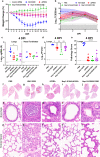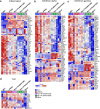Intranasal delivery of a rationally attenuated SARS-CoV-2 is immunogenic and protective in Syrian hamsters
- PMID: 36357440
- PMCID: PMC9648440
- DOI: 10.1038/s41467-022-34571-4
Intranasal delivery of a rationally attenuated SARS-CoV-2 is immunogenic and protective in Syrian hamsters
Abstract
Few live attenuated severe acute respiratory syndrome coronavirus 2 (SARS-CoV-2) vaccines are in pre-clinical or clinical development. We seek to attenuate SARS-CoV-2 (isolate WA1/2020) by removing the polybasic insert within the spike protein and the open reading frames (ORFs) 6-8, and by introducing mutations that abolish non-structural protein 1 (Nsp1)-mediated toxicity. The derived virus (WA1-ΔPRRA-ΔORF6-8-Nsp1K164A/H165A) replicates to 100- to 1000-fold-lower titers than the ancestral virus and induces little lung pathology in both K18-human ACE2 (hACE2) transgenic mice and Syrian hamsters. Immunofluorescence and transcriptomic analyses of infected hamsters confirm that three-pronged genetic modifications attenuate the proinflammatory pathways more than the removal of the polybasic cleavage site alone. Finally, intranasal administration of just 100 PFU of the WA1-ΔPRRA-ΔORF6-8-Nsp1K164A/H165A elicits robust antibody responses in Syrian hamsters and protects against SARS-CoV-2-induced weight loss and pneumonia. As a proof-of-concept study, we demonstrate that live but sufficiently attenuated SARS-CoV-2 vaccines may be attainable by rational design.
© 2022. This is a U.S. Government work and not under copyright protection in the US; foreign copyright protection may apply.
Conflict of interest statement
S.L., C.B.S, P.S., C.Z.L., and T.T.W. are inventors on a patent filed by the U.S. FDA based on the results described in this manuscript. The remaining authors declare no competing interests.
Figures







Similar articles
-
Intranasal or airborne transmission-mediated delivery of an attenuated SARS-CoV-2 protects Syrian hamsters against new variants.Nat Commun. 2023 Jun 9;14(1):3393. doi: 10.1038/s41467-023-39090-4. Nat Commun. 2023. PMID: 37296125 Free PMC article.
-
Immunization with Recombinant Accessory Protein-Deficient SARS-CoV-2 Protects against Lethal Challenge and Viral Transmission.Microbiol Spectr. 2023 Jun 15;11(3):e0065323. doi: 10.1128/spectrum.00653-23. Epub 2023 May 16. Microbiol Spectr. 2023. PMID: 37191507 Free PMC article.
-
Intranasal delivery of a chimpanzee adenovirus vector expressing a pre-fusion spike (BV-AdCoV-1) protects golden Syrian hamsters against SARS-CoV-2 infection.Front Cell Infect Microbiol. 2022 Nov 3;12:979641. doi: 10.3389/fcimb.2022.979641. eCollection 2022. Front Cell Infect Microbiol. 2022. PMID: 36405962 Free PMC article.
-
The Cold-Adapted, Temperature-Sensitive SARS-CoV-2 Strain TS11 Is Attenuated in Syrian Hamsters and a Candidate Attenuated Vaccine.Viruses. 2022 Dec 29;15(1):95. doi: 10.3390/v15010095. Viruses. 2022. PMID: 36680135 Free PMC article.
-
Scalable live-attenuated SARS-CoV-2 vaccine candidate demonstrates preclinical safety and efficacy.Proc Natl Acad Sci U S A. 2021 Jul 20;118(29):e2102775118. doi: 10.1073/pnas.2102775118. Proc Natl Acad Sci U S A. 2021. PMID: 34193524 Free PMC article.
Cited by
-
A multiantigenic Orf virus-based vaccine efficiently protects hamsters and nonhuman primates against SARS-CoV-2.NPJ Vaccines. 2024 Oct 16;9(1):191. doi: 10.1038/s41541-024-00981-2. NPJ Vaccines. 2024. PMID: 39414789 Free PMC article.
-
Human and hamster sera correlate well in identifying antigenic drift among SARS-CoV-2 variants, including JN.1.J Virol. 2024 Nov 19;98(11):e0094824. doi: 10.1128/jvi.00948-24. Epub 2024 Oct 4. J Virol. 2024. PMID: 39365051 Free PMC article.
-
Antigenic cartography using hamster sera identifies SARS-CoV-2 JN.1 evasion seen in human XBB.1.5 booster sera.bioRxiv [Preprint]. 2024 Apr 6:2024.04.05.588359. doi: 10.1101/2024.04.05.588359. bioRxiv. 2024. PMID: 38712124 Free PMC article. Preprint.
-
Differential patterns of cross-protection against antigenically distinct variants in small animal models of SARS-CoV-2 infection.Npj Viruses. 2025 Jun 4;3(1):49. doi: 10.1038/s44298-025-00125-w. Npj Viruses. 2025. PMID: 40467943 Free PMC article.
-
Intranasal or airborne transmission-mediated delivery of an attenuated SARS-CoV-2 protects Syrian hamsters against new variants.Nat Commun. 2023 Jun 9;14(1):3393. doi: 10.1038/s41467-023-39090-4. Nat Commun. 2023. PMID: 37296125 Free PMC article.
References
-
- Khoury DS, et al. Neutralizing antibody levels are highly predictive of immune protection from symptomatic SARS-CoV-2 infection. Nat. Med. 2021;27:1205–1211. - PubMed
Publication types
MeSH terms
Substances
LinkOut - more resources
Full Text Sources
Other Literature Sources
Medical
Molecular Biology Databases
Research Materials
Miscellaneous

